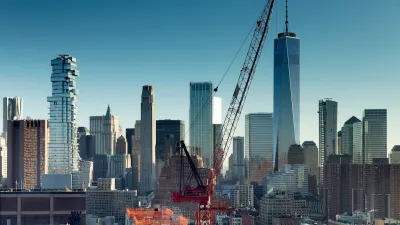For a city of its size, London and its skyline are notoriously flat. Now, as the city struggles to expand its housing stock to meet the needs of it surging population, increasingly taller solutions are being prescribed, concerning some.
An increasing population, coupled with changes in demographics, are placing housing development pressures on a city where many already complain of overcrowding and unaffordability. Zoe Green, of The Global Urbanist, reports on London's increasingly desperate need for housing, "...the Greater London Authority (GLA) anticipates that an additional 32,600 homes will need to be built every year. When, where and whether these come forward remain to be seen."
One solution is to build upwards in a city that lacks density when compared to its peer cities across Europe. According to Green, despite an increase from 59 dwellings per hectare (dph) in 1999 to 145 dph in 2007-08, London doesn't compare to the 300 dph of inner Paris and the 500 dph of central Barcelona. Yet, many are worried about the potentially irreversible changes to London's urban character and skyline. "It is recognised however that tall buildings are not appropriate across the whole city," states Green.
So can increased density be correctly balanced across London's diverse neighborhoods? "We will see exactly how far we are prepared to compromise, but it is more than likely that more deprived parts of the city will have a far weaker hand to exploit as they seek to negotiate their future growth," says Green.
FULL STORY: Is vertical living a solution for London's strained housing stock?

Alabama: Trump Terminates Settlements for Black Communities Harmed By Raw Sewage
Trump deemed the landmark civil rights agreement “illegal DEI and environmental justice policy.”

Planetizen Federal Action Tracker
A weekly monitor of how Trump’s orders and actions are impacting planners and planning in America.

The 120 Year Old Tiny Home Villages That Sheltered San Francisco’s Earthquake Refugees
More than a century ago, San Francisco mobilized to house thousands of residents displaced by the 1906 earthquake. Could their strategy offer a model for the present?

Opinion: California’s SB 79 Would Improve Housing Affordability and Transit Access
A proposed bill would legalize transit-oriented development statewide.

Record Temperatures Prompt Push for Environmental Justice Bills
Nevada legislators are proposing laws that would mandate heat mitigation measures to protect residents from the impacts of extreme heat.

Downtown Pittsburgh Set to Gain 1,300 New Housing Units
Pittsburgh’s office buildings, many of which date back to the early 20th century, are prime candidates for conversion to housing.
Urban Design for Planners 1: Software Tools
This six-course series explores essential urban design concepts using open source software and equips planners with the tools they need to participate fully in the urban design process.
Planning for Universal Design
Learn the tools for implementing Universal Design in planning regulations.
Clanton & Associates, Inc.
Jessamine County Fiscal Court
Institute for Housing and Urban Development Studies (IHS)
City of Grandview
Harvard GSD Executive Education
Toledo-Lucas County Plan Commissions
Salt Lake City
NYU Wagner Graduate School of Public Service





























